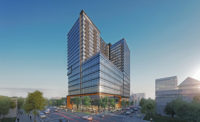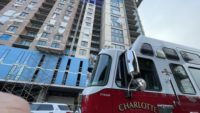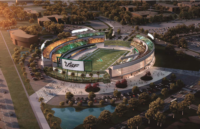City Grill

K.J. Jacobs
Principal
McMillan Pazdan Smith Architecture
For Greenville, S.C., an influx of new residents flocking to the city and a drive among officials for more affordable housing are keeping designers and contractors busy, even in the face of rising interest rates.
K.J. Jacobs, principal at McMillan Pazdan Smith Architecture, says the city of more than 72,000 residents is seeing significant activity in the housing and public facilities sectors. One big topic for the industry in Greenville is the city’s new development code adopted in June 2023. Jacobs says the code was compiled with input from the AEC community in order to align development-related issues with the city’s comprehensive plan. The code focuses on housing, preserving open space and transportation, Jacobs notes, saying it will hopefully speed up the permitting process and minimize entitlement time.
“Having a form-based code with incentives for affordable housing will be a benefit to the future success of our local communities,” says McMillan Pazdan Smith Greenville studio director Lisa Lanni.
Near downtown Greenville, a $1-billion redevelopment of the County Square includes 40 acres of mixed-use retail, dining, entertainment, office and residential space alongside the new 250,000-sq-ft county administration building. That facility is profiled elsewhere in this edition as an ENR Southeast 2023 Best Project in the government/public building category.
The six-story Greenville County Administration Building follows closely on the heels of another project, Unity Park in downtown Greenville, a 2022 ENR Southeast Best Project in landscape/urban development. Work there is ongoing to expand The Commons, a dining and retail destination that connects to the Swamp Rabbit multiuse trail. The popular trail was extended to 17 miles with plans to eventually connect to nearby communities. Extending trail networks in the area continues to be a popular trend, Jacobs says, as the area continues to see the economic benefits it brings, like new restaurants and entertainment venues, big chain expansions and businesses of all sizes opening their regional or national headquarters in Greenville. Thanks to those desirable livability factors, he says the area is seeing a steady stream of new residents from the Northeast, South Florida, Chicago and the West Coast.
Another recent trend is private office space being converted to civic spaces, but Jacobs says the area isn’t seeing the significant corporate office vacancies other cities are seeing.
“We are currently designing more than 200,000 sq ft of new corporate office space,” he says. “For example, Lima One Capital is expanding their Greenville headquarters, which will create 300 new jobs.”
As the community focuses on its workforce and organizations like the Greenville Housing Fund, the city and Truist Bank celebrate an accelerated funding announcement for something Jacobs says the community needs: more affordable housing.
“Funding has shifted toward institutional public sector work with Prisma Health’s investment this year in Greenville Technical College’s 125,000 sq-ft Center for Health and Life Sciences (expected to open in 2024) as a prime example of the area’s focus on supporting local workforce development,” he says.
The A/E/C industry, too, is focusing on workforce development at a time when labor shortages are a constant headache for many contractors. In Greenville, he says, contractors have a healthy backlog and pipeline, and new contractors are focusing on training, which has risen 5% in construction-related fields since 2021.
“I think we’re approaching a tipping point where cost increases will plateau.”
—K.J. Jacobs, Principal, McMillan Pazdan Smith Architecture
But as across the country, interest rates also continue to be a hot topic for Greenville, Jacobs says, but the region is adapting to higher rates, which appear to be tapering off. Those higher rates have softened lending and slowed private development, but the total value of building permits issued in Greenville County for the 2022-23 fiscal year increased 16.4% over the previous fiscal year.
Interest rates aren’t the only costs climbing, though. Rising construction costs continue to be a point of conversation, with contractors pricing in expected cost escalation.
“But I think we’re approaching a tipping point where cost increases will plateau,” Jacobs says. “Supply chain issues have largely been worked out and GCs and subcontractors are looking for work which will affect estimating in a positive direction going forward.”






Post a comment to this article
Report Abusive Comment